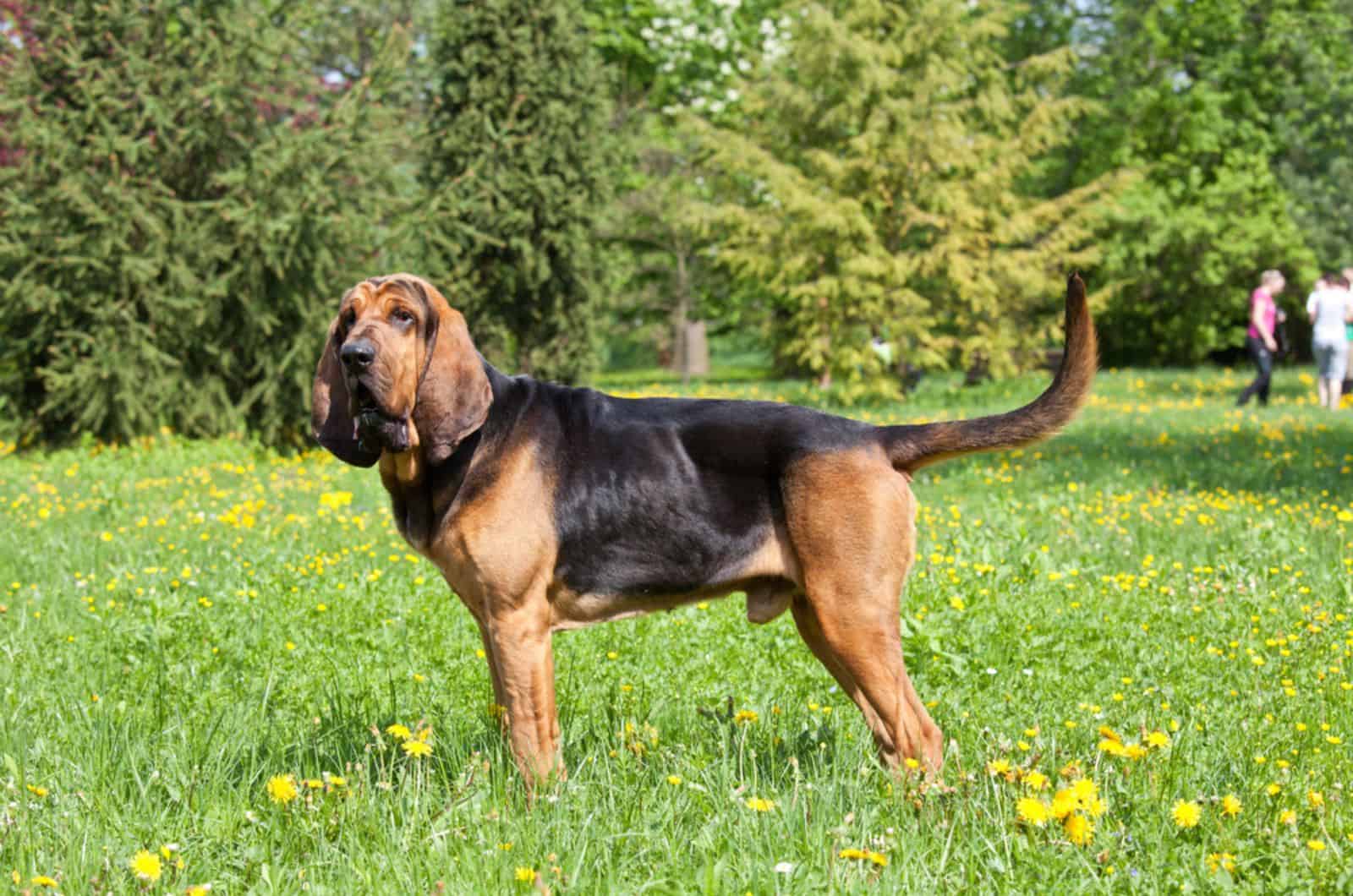It’s the Hercule Poirot of the dog world. They can find what no one can find by using their incredible sense of smell. The nose of a Bloodhound dog is one of the best assets of law enforcement, and it is working all the time — some say even when they are asleep.
This is not a small dog that can crawl into tight spaces in search of small game to help hunters. They are not chasing anything or crawling — they are scent hounds, bred to sniff, bark, and drool! And, it is a large dog.
How big do Bloodhounds get? Luckily, we’ve got a Bloodhound growth chart for both males and females.
You will see that this chart can be quite useful to all those interested in owning a Bloodhound puppy. By using it, you can find out the normal average size of your dog from birth to adulthood.
We will talk about its weight chart, but it is good to know that a female Bloodhound can grow up to 25 inches tall, and her male counterpart, up to 27 inches tall. The height was measured in the usual way — from withers to ground.
But, weight fluctuates much more than height, and it can be influenced by various external and internal factors, from the amount of exercise and a balanced diet to genetics and diseases.
It’s time to uncover the one that keeps uncovering and find out all about the Bloodhound’s size and development from day one to one year.
Bloodhound Growth Chart
According to the AKC (American Kennel Club) breed standards, an adult Bloodhound can weigh more than 100 pounds, which means they are a large breed.
Don’t get fooled by its looks. They might be as cute as Beagles, but they are stubborn like Bulldogs. A Bloodhound is an active dog that is not that easy to teach the difference between good and bad behavior in obedience training because of its stubbornness.
Also, there is a difference between a male and a female Bloodhound’s growth chart because females tend to be smaller (both in height and in weight) than males.
That’s why we have two growth charts — one for males and one for females. These differences are important to acknowledge because they can cause confusion if you have male and female puppies. You might think your female is not developing properly because she is much smaller than a male.
But, actually… she’s perfectly normal, and fits under the average weight of a Bloodhound female puppy.
Let’s take a look at the growth chart and see how big those droopy long ears get.
Male Bloodhound Growth Chart
[table id=711 /]
Female Bloodhound Growth Chart
[table id=712 /]
Bloodhound Growth Through Different Life Stages
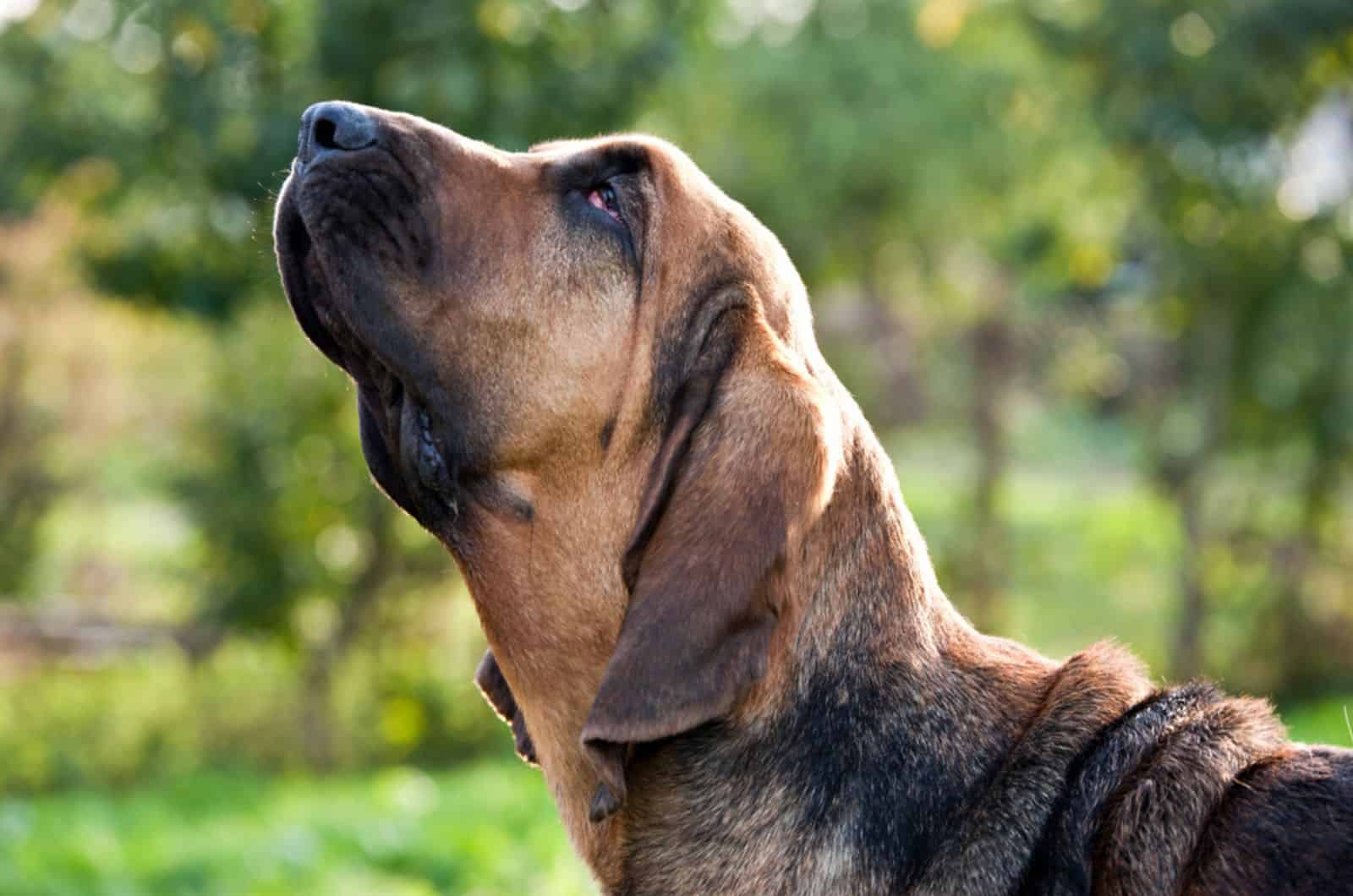
This high-energy dog has rapid puppy growth. They start with a couple of pounds at birth, and they grow during their puppyhood into big dogs weighing more than 100 pounds.
During this process, their entire body will get bigger — rib cage, leg bones, ears, etc. As you’ll see, we’ll talk about each stage represented in the Bloodhound growth chart, from the neonatal stage until they reach adult size.
In all stages, a female Bloodhound will be slightly smaller than a male Bloodhound. The only time when we can expect the pups to have the same average size is during the first couple of days after birth.
But, soon after… the boys start to gain puppy weight much faster than the girls. In some cases, male pups can have the same weight gain as females. This is because of the influence of certain factors coming from inside and outside the puppy’s body.
We will talk about these factors later. Right now, let’s see the changes that happen during each growing stage of a Bloodhound’s life.
Birth To 3 Months
This is the most rapid stage of the puppies’ life. They should double their weight after two weeks. Most Bloodhound pups will weigh around 7 pounds at birth. This can vary — some can be much smaller or much larger.
From the day they are born until the third or fourth week of life, puppies only drink their mother’s milk. That is their only source of food, and it is a very important one. The first milk that the female dog produces is called colostrum.
Colostrum is filled with antibodies that will be the only defense cells in the newborn pup’s bloodstream until it can make its own antibodies.
Also, puppies are born deaf and blind. They can only smell their mother’s scent and feel her warmth. After three to four weeks, their mom will instinctively start to forbid the puppies to drink milk.
She’ll no longer produce milk, and it is time for them to start eating solid food. This is called the weaning process, and it is a natural way of doing things.
Weaning Process
Puppies can’t survive on milk their whole time during puppyhood. It is a normal change that can be a bit of a surprise for the puppies. What are they going to eat now?
Well, that’s why we are here to help them. As soon as you notice that the mom dog is refusing to feed her pups, and she starts bringing them food that she eats, it is time to get involved.
This is the period during the dog’s life when we can free-feed them. This means we can leave food available for the dogs to eat whenever they want. The amount of food shouldn’t be constrained — the puppies have high activity levels and they need a lot of nutrients.
In order to help the puppies transition easier from milk to solid food, we can make puppy mush. This is kibble (dry dog food) softened in warm water or sometimes milk or yogurt.
The puppies are growing rapidly, and they require lots of energy that they get from food, but don’t forget their mom! She needs high-quality food as well. Having five to six pups is exhausting, and we need to give the mom lots of food and fresh, clean water, too.
Mom dogs can eat puppy food as well, but there are special formulas of kibble food that are made specifically for the weaning period that both mom and the pups can eat at the same time. This is a type of food that is high in proteins and low in carbohydrates.
3 To 4 Months
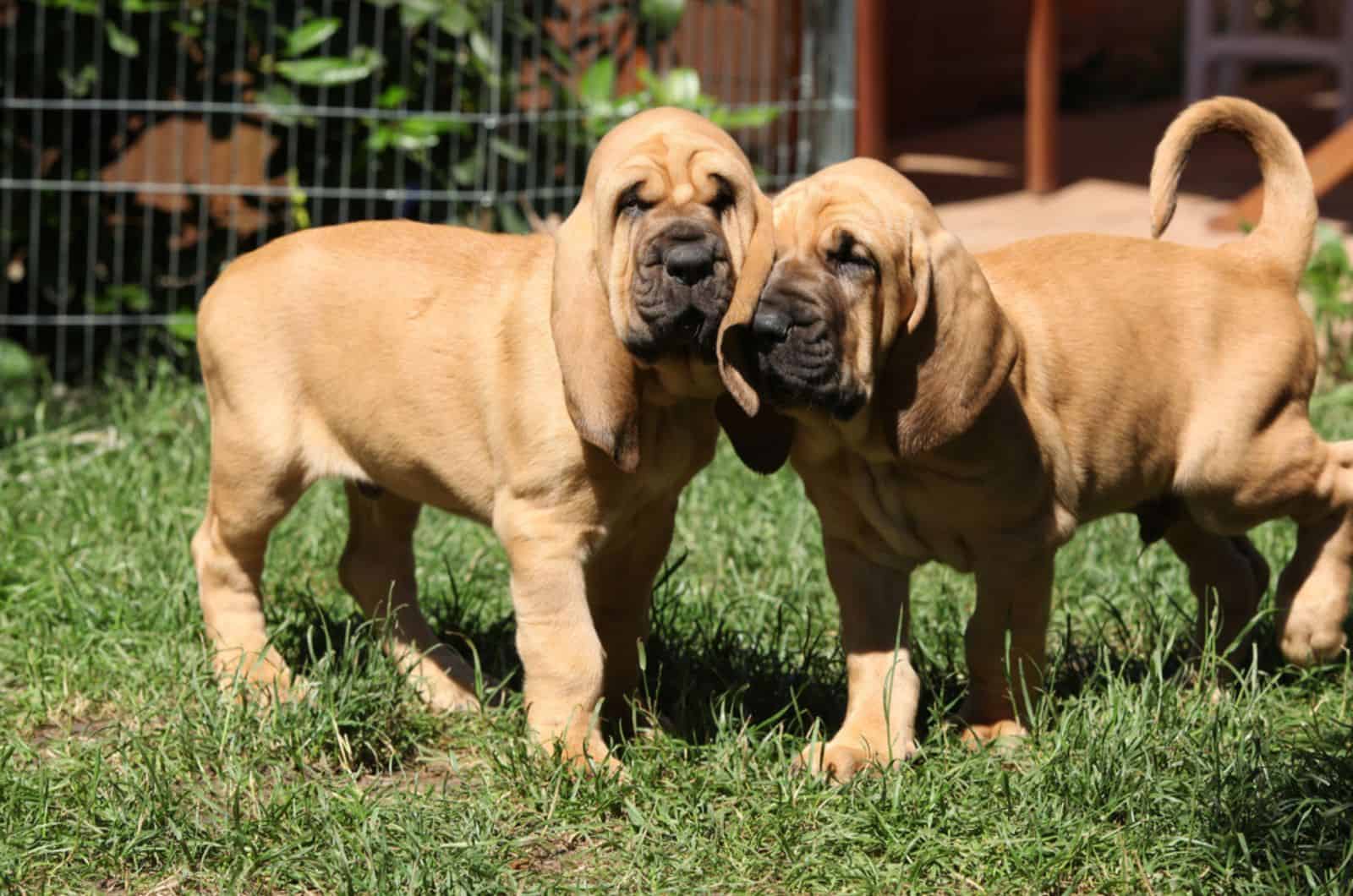
With the fourth month peeking around the corner, we can see from the Bloodhound growth chart that the male puppies approximately weigh 42 pounds. Females should weigh a little less — around 40 pounds.
The puppies are continuing to grow so fast that you can almost see them actually grow in front of your eyes. But, they still have a long time until they reach their adult weight. Also, the growth doesn’t necessarily follow sexual maturity, especially in big dog breeds.
Your pups might be getting closer to the fifth and sixth month of age, but they are not like Chihuahuas or other small dogs. The big ones, like a St Bernard, a Bullmastiff, or our Bloodhound mature more slowly.
This will come as important later when you’ll have to decide when to spay or neuter your dog. Some say spaying/neutering can cause obesity in dogs. But, this is still debatable, and nothing has been proven as 100% true so far.
Teething Period
When the third week is finished, the puppies start with the teething process. Their small baby teeth (or deciduous teeth) start to erupt one by one. This period can be quite an annoyance for the pups.
You will notice symptoms associated with teething. Some symptoms are barely noticeable while others might cause some concern, but there is nothing to worry about.
The teething causes gum irritation that can cause pain. But, in most cases, it is just a discomfort they feel. However, they have to do something with this annoying feeling, and what do puppies do the best? They chew…
The puppy might also avoid food for a while, they can start drooling more than usual, and they can whine or cry while playing with their toys. Because the inflamed gums cause the pups to avoid solid food, you can continue making puppy mush during this period.
Also, be sure to give the puppies enough toys to chew on, which will help them with their teething problem. Sometimes, a cooled carrot can help with the irritation.
5 To 6 Months
At the start of the fifth month, male Bloodhound puppies should weigh from 51 to 60 pounds, and females, from 49 to 57.
The puppies are getting more and more active, and for Bloodhound puppies, that means a lot of sniffing and exploring. If they get a scent that they think they should follow — good luck stopping them. This is the stubbornness of the Bloodhounds we talked about earlier.
By now, the puppies should have learned what is considered good and what is considered bad behavior. The process of socialization practically starts from the first day, but the hardest work happens during this period.
They are entering their teenage phase, and this is the time when the puppy blues start. You might feel like you are unable to cope and control the pups, and that it was all one big mistake. Don’t worry — the feeling will pass.
We’ve all been there, and it is normal to feel that way. The best way to control the puppies is to be sure to make a puppy schedule. It will help both you and the pups.
By the end of the sixth month, female puppies should weigh from 60 to 67 pounds, and male puppies should weigh from 60 to 69. As you see, this is the period where some female puppies can be the same size as males.
This happens because of the sex hormones that suddenly start to fill the bloodstream and influence the future development of the dogs.
Even though big dogs mature later, it wouldn’t be a mistake if you consult your veterinarian about the proper time for spaying or neutering your dogs. You can also call a breeder and ask them about their dogs, and when they became sexually mature.
7 To 8 Months
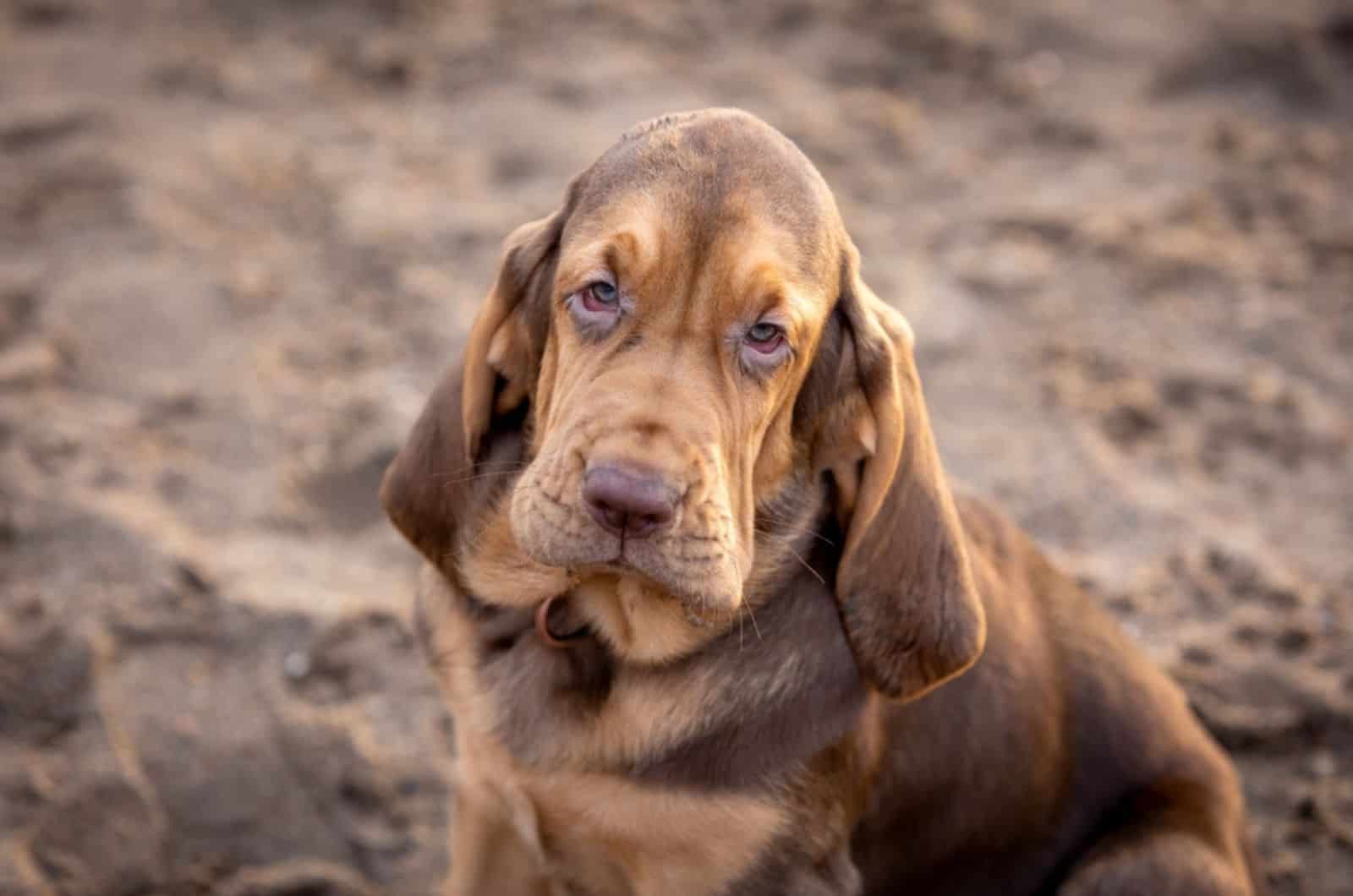
Puppies continue to grow, and they constantly seek new paths and objects to explore. If you have a yard where you let your puppies roam free, you can see that they start digging, paying more attention to small animals — all the while learning about hunting from their mom and other big dogs.
If you have the whole puppy litter at home, you have a lot of amazing hunting dogs at your home. There is no smell that can pass them unnoticed.
You will have to be very patient and firm if you want to socialize them properly and teach them not to chase cats, squirrels, or other smaller animals.
The puppy blues might not be as hard as when this whole puppy chaos started, but they are still a handful. The puppies do get better over time, and they will calm down.
By the time they reach the 8th month, male puppies should weigh 77 to 85 pounds, and females should weigh from 73 to 82 pounds.
They are getting bigger, but it’s not the end. They still have around 20 pounds to gain. It is important to keep the dogs both mentally and physically active. Keeping their brilliant sleuth mind occupied prevents boredom and destruction in Bloodhounds.
9 To 10 Months
As they go through the ninth month and enter the tenth month, the puppies slowly start to lose their puppy looks. They are not adults, but they are not small babies anymore.
They are in between — true teenagers.
Even though they have a lot to learn, they are showing the characteristics of the best dogs for finding what you’ve lost. Their instincts are kicking in, getting stronger by the day. This is a trait of Bloodhound mixes as well… not just purebred dogs.
When we look at the Bloodhound growth chart, we can see that by the end of the 9th month, male puppies should weigh around 90 pounds, and female puppies should weigh around 87 pounds.
As mentioned, they might look like adult dogs, but they don’t need adult food — not yet. They will need a puppy-adjusted dog’s diet that includes puppy food full of vitamins, minerals, and of course — high in proteins.
11 To 12 Months
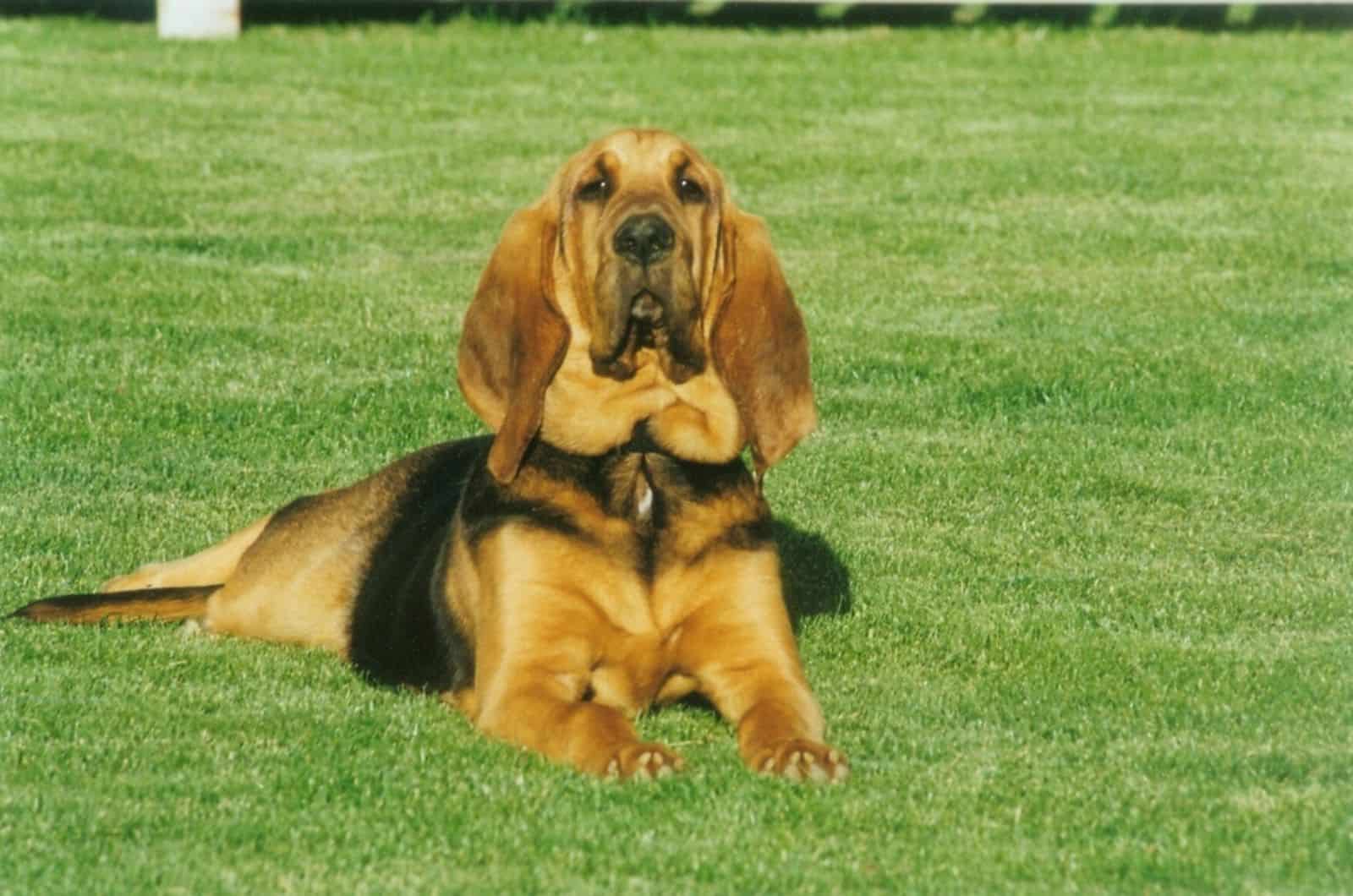
The male and female Bloodhound puppies are almost the same size as adult dogs. At the beginning of the 12th month, male puppies should weigh around 110 pounds, and female puppies, around 100 pounds.
Some dogs stay this size and others gain a few more pounds. It is individual, and both versions are normal.
The dogs should still have puppy food, and they should be fed as adults — two meals a day. One meal is in the morning and the other one is in the evening.
This way, we avoid obesity and more serious health problems like bloat (Gastric dilatation-volvulus).
As the puppies approach their adulthood, you should start paying attention to signs your dog needs to be neutered or talk to your vet about the right time for not only spaying females, but neutering males also.
Adult Years
When the dogs turn one year old, males should weigh from 110 to 115 pounds, and females should weigh from 100 to 110 pounds. That is about 45 kilograms for females and around 50 kilograms for males.
It is time to start feeding your dog adult dog food. This food should still be low in carbohydrates and high in proteins. But, it is very important to keep your dog physically active by having daily exercise or daily walks.
These walks shouldn’t be just short walks, but time enough to genuinely tire your dog (in a good way) so that they feel happy and ready to go back home to lounging on the sofa with you.
People often represent Bloodhounds as lazy dogs, but they are hounds with incredible hunting instincts and high energy levels. They are not meant for the life of a low-energy dog breed. They need their daily physical and mental stimulation.
Of course, you’ve been keeping your pups safe and you have made sure they are healthy, but this doesn’t stop when they reach adulthood.
You have to continue taking your dog for regular vet checks, deworming processes, and revaccinations. They need proper food, grooming, and lots of love.
Senior Years
The Bloodhound growth chart tells us about the development of the Bloodhound puppies — both male and female. But, dogs can gain weight after this developmental phase ends. This additional weight gain is considered bad, especially if it turns into obesity.
Senior dogs are not immune from this condition. As a matter of fact, they are even more prone to obesity because they don’t have the stamina and will to play as they used to play when they were young.
If you want to be sure your dog is still in good shape, even after they grow out of their developmental phase — you can use the Body Condition Score to determine if your dog is underweight, normal, or overweight.
Pay attention that Bloodhounds usually live up to 12 years, which means they enter their senior phase at around the 9th year or earlier.
What Can Influence Bloodhound Growth?
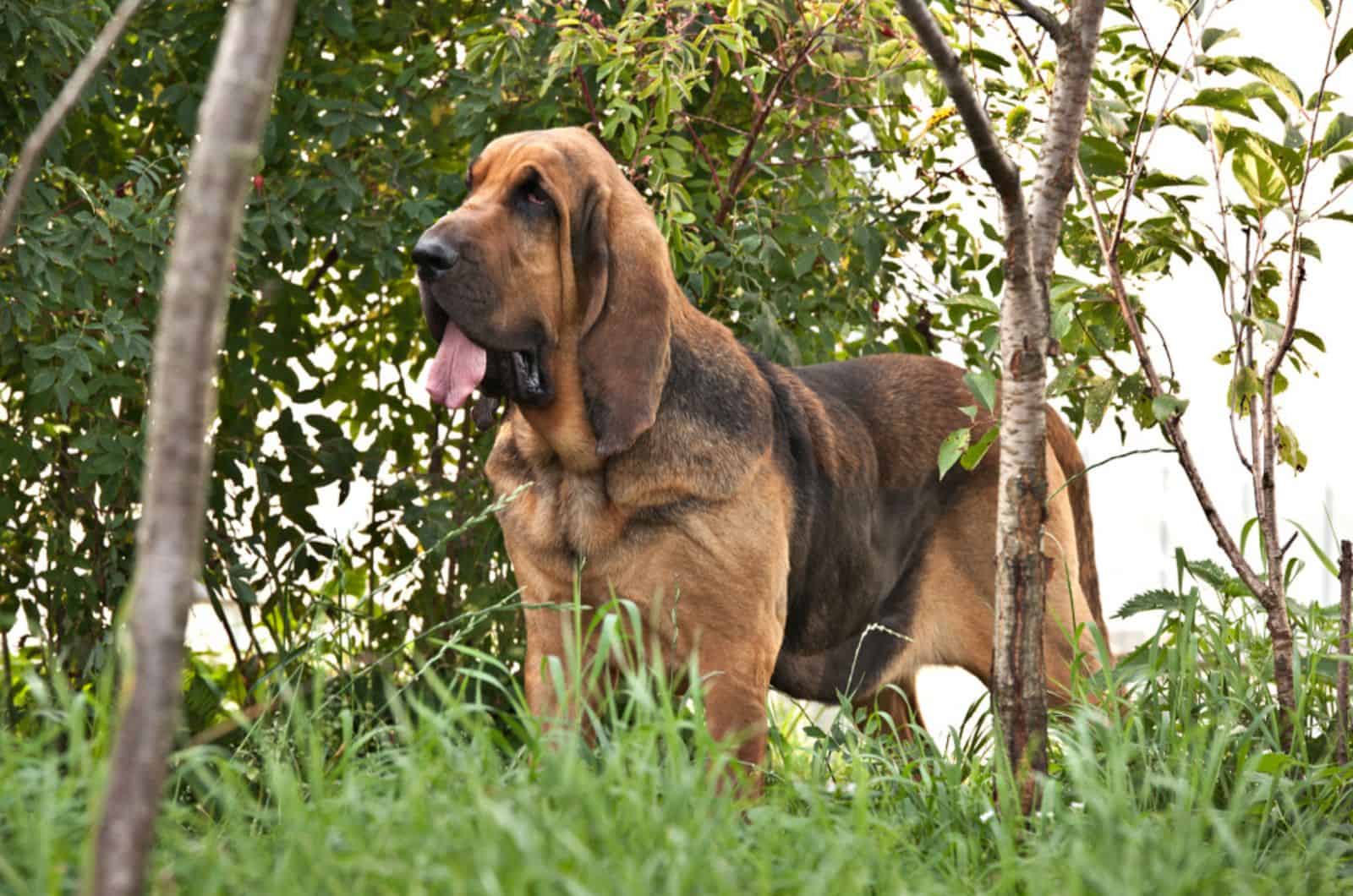
In the beginning, we mentioned that there are some external and internal factors that can influence the growth chart of Bloodhound puppies.
The internal factors are:
- Genes
- Hereditary diseases
- Hormones
The external factors are:
- Bacterial and viral diseases
- Amount of exercise
- Injuries
- Diet
Not every factor has the same influence on the development of puppies. For example, genes play one of the major roles. Mutated genes can cause total dwarfism that can lead to very short and much smaller Bloodhound puppies.
Even though this is extremely rare, it can still happen, especially if you don’t have purebred puppies, but designer puppies — where one parent is a purebred Bloodhound and the other one is some other purebred dog breed.
Diseases that can often be seen, and that can change the puppy’s size during their growing phase, are hookworms and roundworms. They literally eat away all the food that the puppy eats. Luckily, deworming is a common and successful method for getting rid of these parasites.
The Conclusion
By looking at the Bloodhound growth chart, we can see that both male and female Bloodhound dogs are large dogs. Having a dog that weighs around 100 pounds is not the same as owning some small fluffy dog breed.
The Bloodhound needs space and exercise. They are bred for work and they love it. If you can’t give your dog some work to do, then make sure to give him enough daily exercise.
Use interactive dog toys if you have to, but don’t leave such an amazing hunting dog alone for too long and bored for too long. Any dog with such intelligence and high prey drive will turn into a destructive and disobedient dog.
They won’t know what to do with their time and energy so they’ll choose the easiest solution — chewing, digging, and even peeing where and when they shouldn’t pee.
Don’t hit your dog for misbehavior. There are ways to train your dog without using force or an increased voice. Most of the time, it’s either exercise or playtime that they need.
Take your Bloodhound to the park and let it enjoy all the smells that a dog can find outside. Let it run and play with other dogs or with you, and I am sure your dog will calm down and be very grateful for everything you did for him.
